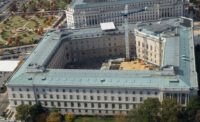Top Design Firms Report $4 Billion in Billings During 2014
























Architects and engineers hit their full stride during 2014. Annual revenue for work in the region was up nearly 11% among the almost 100 firms participating in ENR California's annual design firms survey. And, for the first time since the survey has been conducted, the cumulative total for participating firms topped $4 billion.
"CO Architects' outlook for 2015 is very positive," says Scott Kelsey, the firm's managing principal. "Our backlog of work has increased significantly from 2014, and our ability to see further out in the future with respect to substantial revenues for the firm is much greater than in prior years."
A number of Bay Area projects, such as the $1.1-billion Salesforce Tower, helped BKF Engineers to increase its 2014 design revenue above $54 million for the first time in its 100-year history. President and CEO David LaVelle says the firm is on track to grow another 15% this year due to an upsurge in residential and commercial office development.
Multifamily revenue jumped 71%, and commercial revenue rose 16%.
Revenue from these burgeoning markets quickly filters into other sectors. "It's like a perpetual motion machine. Technology, feeding the office market, drives the multifamily residential market ... which then causes increased pressure on infrastructure for public agencies," says Gary M. Cappa, president and CEO of Consolidated Engineering Laboratories.
Many firms build teams that straddle disciplines to take advantage of these trends. BKF, for example, designs infrastructure for 25,000 new residential units in San Francisco. "These projects require us to use all of our expertise in the entitlement process, infrastructure design and traffic mitigation," LaVelle says.
Development money flowing in from overseas increasingly boosts development in both San Francisco and the Southland. "Los Angeles is showing no signs that the recent spate of development will stop soon, and in fact, foreign investment continues to grow," says J. Peter Devereaux, principal and CEO of Harley Ellis Devereaux. "We are currently working with three different development groups out of China on very large projects in addition to the U.S. developers we have traditionally served."
The growing network of mass-transit lines in the state provides added traction that especially benefits mixed-use projects. "This development phenomenon is spreading to other rail hubs connected to downtown L.A., like Anaheim and Pasadena," Devereaux adds.
The lingering drought poses one of the only dark clouds hanging over the Golden State, but even that crisis is providing ample design opportunities.
"Managing increasingly scarce water resources is one of the biggest challenges facing the state," says Louis Armstrong, AECOM's Pacific region executive. The firm's recent acquisition of URS better positions it to help its clients address complex water conservation, supply and storage issues, he says.
Investment flooding into water infrastructure stems from local stakeholders and the recent statewide $7.5-billion water bond. "Every possible local source of water is being considered," says Dave Harrison, California regional manager with MWH Global. "Brackish or impaired groundwater basins, seawater, stormwater and municipal wastewater are the big opportunities."
Some firms are shifting design strategies to help mitigate the drought's impacts. "Our area of focus will be on low-impact development," says Rob Hedrick, principal and California business unit manager for Cardno. "We plan to emphasize development of methods to harvest rainwater and recycle water—areas where our expertise will be a huge asset in the search for lasting, cost-effective solutions."















